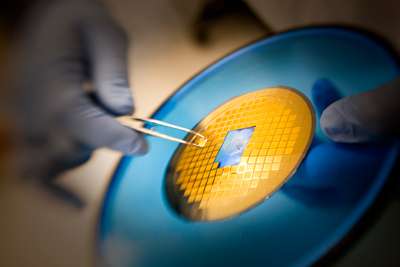June 14, 2013 report
Nanopatch: Syringe and needle replacement unveiled at TEDGLobal Conference

(Medical Xpress)—Professor Mark Kendall of the University of Queensland, Australia, has announced at this year's TEDGLobal Conference that a skin patch he and colleagues have developed will soon begin field testing in New Guinea. The Nanopatch, as it's been named, is used as a replacement for the traditional method of administering vaccines—injection with needle and syringe.
Currently a vaccine is injected into muscle tissue where it encounters immune cells, triggering a response. In contrast, the Nanopatch, which has thousands of projections on the skin side, injects the vaccine just under the skin, where Kendall notes, there are more immune cells. This means, he added, that less vaccine is needed to accomplish the same goal which in turn means each dose would cost far less.
One of the major problems with current injectable vaccines is that they are water based, which means they have be kept chilled to prevent spoilage. This can be a major problem for vaccination programs in areas where there is limited refrigeration facilities. Kendall cited recent reports that suggest up to half of the vaccines administered in Africa don't work properly due to refrigeration issues. With the Nanopatch, the vaccine is dry, thus it doesn't have to be kept chilled. Each patch is silicone based and has 20,000 micro-sized projections on its underside that deliver the vaccine—it's smaller than a typical postage stamp. Because the projections are so small, they cannot be felt piercing the skin, making the application of the vaccine completely painless. Thus far, testing of the Nanopatch by the development team has involved administering the flu vaccine to volunteers.
Kendall and his colleagues are working with Vaxxas, a newly created company whose mission is to commercialize the Nanopatch. They plan to begin field trials of the patch as soon as possible in New Guinea where HPV virus infection rates (along with cervical cancer) are the highest in the world. Not coincidently, the country also has very few refrigeration facilities making it an ideal candidate for testing the new patch.
Kendall added that another advantage of the nanopatch is that it requires the use of much less adjuvants—chemicals added to vaccines to provoke a better immune response. Some of these adjuvants have been suspected of causing health problems, and in some cases autism, though no proof has ever been found. Looking ahead, Kendall said he believes the Nanopatch will soon become available for use against malaria infections as well.
© 2013 Medical Xpress














